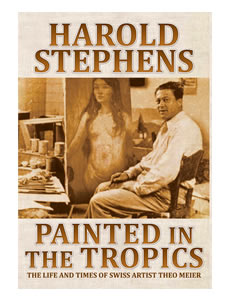 If you’re like us, you weren’t prepared to find that the Indonesia’s island of Bali hosted a number of extraordinary expat painters. Balinese museums and private collections are full of their work, and the viewer is left wanting to know more about these extraordinary artists. Noted expat Asian author Harold Stephens provides many important details of the people behind this movement in his Painted in the Tropics: The Life and Times of Swiss Artist Theo Meier (2013, ISBN 978-0-978695-17-0).
If you’re like us, you weren’t prepared to find that the Indonesia’s island of Bali hosted a number of extraordinary expat painters. Balinese museums and private collections are full of their work, and the viewer is left wanting to know more about these extraordinary artists. Noted expat Asian author Harold Stephens provides many important details of the people behind this movement in his Painted in the Tropics: The Life and Times of Swiss Artist Theo Meier (2013, ISBN 978-0-978695-17-0).
The book is primarily about Meier, a legendary character who left Switzerland at an early age, abandoned the family business, and sailed to the South Pacific. Like many young artists of his time, his travels initially took him to Tahiti to follow the romance of Gauguin. Where Meier found his paradise, however, was in Bali, where he lived and painted for twenty years. In in this era that Meier meets the expat artists whose paintings would comprise much of the work seen in today’s museums in the city of Ubud, people such as Walter Spies, Rudolph Bonnet, Arie Smit, and Adrien-Jean Le Mayeur de Merpres.
The Pacific War was to change all that, as Japanese occupation took its toll. And when things finally settled, the Sukarno years eventually created an environment unfavorable to expat artists (as the book details, Sukarno would raid their collections to build his own). Meier ended up in Chiang Mai, Thailand, where he remained for twenty years until he passed away.
 Chiang Mai is where author Stephens met Meier and they became close friends. But as the author discusses, being friends with the mercurial Meier was anything but easy. After massive drinking bouts, the artist was known to have become angry enough to poke both friends and foes in the nose, or dash their drinks to the floor. A passionate cook, he would host massive village-wide parties on his birthday. He loved women, the subjects of many of his paintings, slept with some of his models and married others. He claimed, in a comment that Stephens would only reveal after his death, that he painted best when having an erection.
Chiang Mai is where author Stephens met Meier and they became close friends. But as the author discusses, being friends with the mercurial Meier was anything but easy. After massive drinking bouts, the artist was known to have become angry enough to poke both friends and foes in the nose, or dash their drinks to the floor. A passionate cook, he would host massive village-wide parties on his birthday. He loved women, the subjects of many of his paintings, slept with some of his models and married others. He claimed, in a comment that Stephens would only reveal after his death, that he painted best when having an erection.
Writing of the romance of the South Seas and Southeast Asia is Stephens’ forte and passion, and this book encompasses many stories and people that only touch on Meier peripherally, yet are fascinating in themselves. Anthropologist Margaret Mead, musicologist Colin McPhee, and photographer Henri Cartier-Bresson are just three among the numerous larger-than-life personalities that make appearances.
This book is extraordinarily important for its contribution to the study of expat artists in Bali, and fills in the gaps in the life of an artist that heretofore had remained somewhat of an enigma. These three hundred pages contain fascinating stories, told by a man who knew the protagonist well. For lovers of Balinese expat art, the romance of the South Seas, and the general expat culture of the 20th century, this book is a must-read.
Leave a Reply